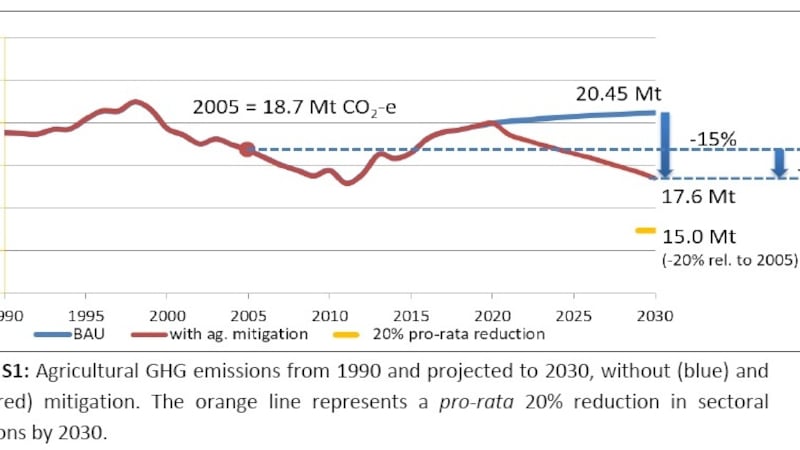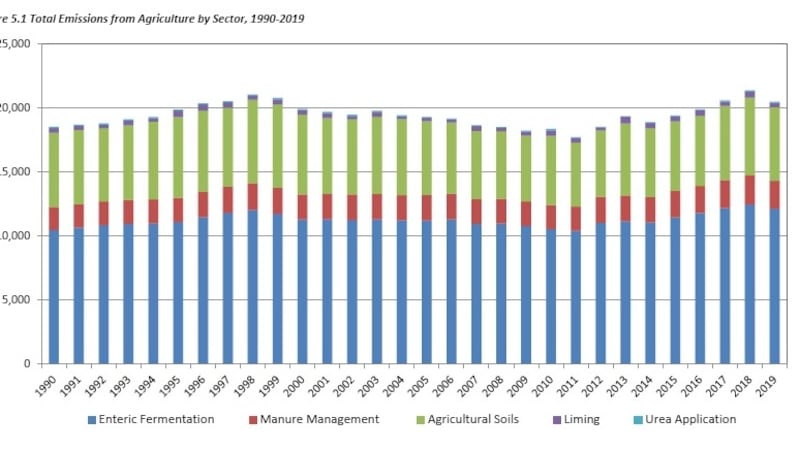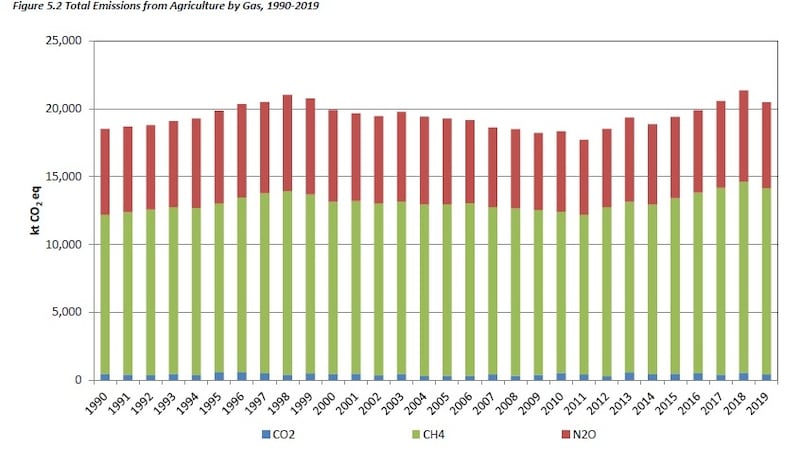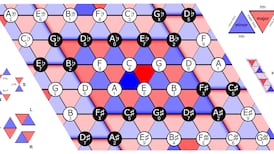Cork dairy farmer Harold Kingston turned to social media in May to voice his anger about how farmers are often portrayed as destroying the environment. Standing in a field of cows and pointing to a grove of trees planted when his father was a teenager, he said that it takes generations to farm the land.
“I’m proud to be a farmer. I’ll use science to look after the land and make sure these cows are healthy. My soil was tested in the springtime and found to be low in lime and phosphorus so lime was spread to increase soil nutrients. I’m also using low emissions slurry spreading equipment and both of these measures cut down on the amount of nitrogen fertiliser needed which reduces nitrous oxide emissions,” he explained. Kingston also uses breeding techniques which result in higher milk yields from the same number of cows.
His anger is echoed by other farmers across the country who are introducing changes to their farming methods to reduce greenhouse gas (GHG) emissions on their farms. Yet, the Irish agricultural sector accounts for one third of GHG emissions – the highest share of emissions from agriculture in Europe. The agri-food sector is our largest indigenous industry with 90 per cent of food produced in Ireland exported. And with recent plans for new food plants here, reducing emissions in agriculture will be particularly difficult.
Climate Action Network (CAN) Europe recently reported on the draft national Common Agricultural Policy (CAP) strategic plans of five EU states including Ireland. That report found that Irish agricultural emissions increased by 8.7 per cent from 2014-2019 with methane emissions increasing by 10 per cent and nitrous oxide emissions increasing by 7.7 per cent.
Agriculture-derived methane, the vast majority of which is emitted by cattle, makes up about 65 per cent of agricultural GHG emissions. Nitrous oxide, which comes from spreading fertilisers and slurry on agricultural land accounts for about 30 per cent, with CO2 making up the remaining 5 per cent.
The CAN report points to a 24 per cent increase in dairy cows in Ireland from 2014-2019 (coinciding with the end of the EU milk quotas) and a further increase of 3.7 per cent in 2020 bringing the total to 1.57 million cows as not being aligned with the Government’s commitment to an average 7 per cent annual GHG emissions reduction. Eighty per cent of agriculture emissions are directly associated with animals.

Calls for the reduction in the national herd to reduce levels of methane gas were strongly refuted by the director of Teagasc, Prof Gerry Boyle (who is also an ex officio member of the Climate Change Advisory Council) at the recent launch of the Signpost Programme: Farmers for Climate Action.
He argued that it makes little sense “to engineer a precipitous reduction in ruminant livestock numbers... as animals are essential to the production of meat and milk”.
“Biogenic methane is a short-lived gas compared with carbon dioxide or nitrous oxide. If the production of biogenic methane can be stabilised, then this source of global warming will be neutralised,” he said.
Some international experts agree there is much less long-term additional warming from biogenic methane emissions from a stable national bovine herd. However, while methane gas only stays in the atmosphere for between 12 and 15 years compared to hundreds of years for CO2, methane is currently calculated in national GHG inventories as having a warming effect that is 28 times higher.

Currently, the main driver to reduce methane and nitrous oxide emissions in agriculture is the Marginal Abatement Cost Curve (MACC) Teagasc report for agriculture 2021-2030. And the new Signpost Programme: Farmers for Climate Action has been set up to put the 14 measures identified in this report to reduce agricultural emissions into practice; the report also identifies other land use and energy mitigation measures.
Tom O’Dwyer, manger of the Signpost Programme, said it represents the first large-scale drive to reduce GHG emissions in Irish agriculture. “It’s the first co-ordinated campaign to put climate action first and centre. MACC identified the technologies we need to promote and what we now need is intensive knowledge transfer to enable farmers to take on these technologies.
“If these technologies are adopted following the assumptions [of the rate of adoption by farmers] in the MACC, we are confident we will reduce agricultural emissions by 15 per cent by 2030,” O’Dwyer added.
The five-year programme will establish a network of up to 100 “signpost farms” across Ireland as demonstration sites for the reduction of GHG emissions and carbon sequestration measures. The idea is that other dairy, beef and tillage farmers with similar soils and climatic conditions will follow their lead.
Many of the identified measures (eg low emissions slurry spreading, testing and treating soil to reduce fertiliser use, establishing multi-species grassland, better animal health and breeding) also have the potential to improve water quality and biodiversity while reducing fertiliser costs and creating more sustainable farming practices.
The Department of Agriculture's Ag Climatise National Climate and Air Roadmap has set a target to reduce the use of nitrogen fertiliser by about 20 per cent by 2030 (from 2018 levels) which it claims would reduce nitrous oxide emissions by 40-50 per cent. Nitrogen fertilisers account for about 12 per cent of agricultural GHG emissions.
“Our success will be calculated by the reduction of fertiliser purchased following measures such as incorporating clover and other species into ryegrass, low-emission slurry spreading and soil testing,” O’Dwyer said, agreeing that the programme will have to evolve to reflect changes in climate change regulation and policy.
Another key aspect of the programme is that more than 30 industry partners including many milk and meat processors, State organisations such as An Bord Bia and farming organisations have signed up to support the farmers.
O’Dwyer said food processors can support farmers taking climate action by paying a premium to farmers who reduce emissions. “Milk purchasing companies could incentivise farmers to take on certain activities by giving them a bonus on milk prices if they meet certain targets for emissions reduction,” he said. Forthcoming changes to the EU Common Agricultural Policy payments will also impact on farming practices.
Speaking at the launch of the Signpost Programme, Prof Frank O’Meara, director of research at Teagasc said consumers want food with a low environmental footprint and now is the time to show GHG emissions can be reduced from agriculture. “Every farmer must set out on a sustainability journey. This is the decade of change for Irish agriculture. We need to protect the carbon stored in soils, reduce farm emissions and sequester carbon in grassland and hedgerows,” he said.
As part of the programme, farmers will measure and monitor the movement of carbon through the atmosphere and in soils. “In five years time, we will have a figure for the carbon dioxide stores in hedgerows and on farms as a model for the carbon stored at various locations across Ireland,” O’Dwyer said. The National Agricultural Soil Carbon Observatory will also measure carbon sequestration levels on farms and many hope that in the future this figure can be used to offset remaining GHG emissions on farms.

Measures farmers can take to reduce emissions
– Changes in fertiliser use, such as using protected urea instead of calcium ammonium nitrate (CAN), reduces ammonia gases emitted by up to 76 per cent. Unprotected urea fertiliser will be phased out by 2023 and 65 per cent of all CAN must be applied in a protected form by 2030.
– Keeping soil to the optimum Ph level by adding lime to neutralise acidic soils which will reduce the amount of fertiliser needed and thereby reduce nitrous oxide emissions.
– Using low-emissions slurry spreading equipment to reduce nitrous oxide emissions. The target is to have 90 per cent of livestock manure spread in this way by 2027.
– Changing grassland from monoculture of ryegrass to mixed species swards. Clover fixes nitrogen in the soil which reduces the amount of nitrogen fertiliser required thereby reducing nitrous oxide emissions.
– Breeding more efficient animals, either for milk production or beef, can reduce the number of animals required to make the same profits. This so-called Economic Breeding Index will reduce methane levels on farms assuming farmers don’t increase stock levels to make a higher profit and instead set aside some land for biodiversity.
– Adding seaweed to animal feed to reduce methane emissions is under investigation. A study at Penn State University in the US found lactating dairy cows decreased methane emissions by 80 per cent without impacting feed intake or milk yield. However, the researchers expressed some concern that the microbes in cows rumens could adapt to the additive thereby reducing the effectiveness of methane reduction over time.











